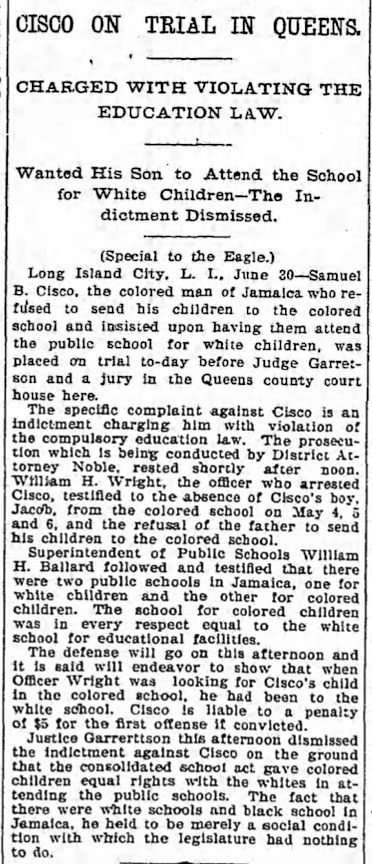You are here:
Cisco on Trial in Queens

Date: Sep 3, 1896
Caption: The Brooklyn Daily Eagle reported on a dramatic moment in what it later called the “Jamaica school wars.” Samuel B. Cisco tried to enroll his children, who were Black, in the local segregated white public school. White school administrators denied them admission. Mr. Cisco then refused to send his children to the segregated “colored” school. Officials responded by charging him with violating New York’s law requiring school attendance for children.

Samuel B. Cisco, a Black man, lived in Jamaica, in Queens County. At the time of this newspaper article, in 1896, Queens was not yet part of New York City, and Jamaica was a small town surrounded by a rural landscape. Mr. Cisco ran a successful scavenger business. He and his wife Elizabeth had six children.1 Although Mrs. Cisco is less visible in the article, she worked alongside her husband and continued their fight for years after his passing.
In coordination and collaboration with many of their Jamaica neighbors, the Ciscos worked tirelessly to challenge the segregation and inequality that affected their children’s education.
Between 1895 and 1900, Black parents initiated twenty court actions against school officials while sustaining a years-long boycott of Jamaica’s “colored school.” Jamaica’s Black parents made great efforts to secure an equal education for their children. Many of the Cisco’s collaborators were laborers, coachmen, servants, and janitors, and, therefore, were especially vulnerable to negative consequences for their activism.2 Their bosses, most of whom were white people, could have fired them for their participation.
Speaking to a reporter in 1896, Mr. Cisco explained: “I and my father and mother have paid taxes in Jamaica for eighty years, yet I am denied a place in the school near my house, while Irishmen, Italians and Dutchmen who have been here only three months, can go in these, although covered with dirt.” He continued, “I am a man of means in business here and yet on September 3, when my three children were sent to school where my neighbors’ children attend, they were put out and sent home crying. The colored school is three-fourths of a mile further away than the white School No. 3, and it is in the low swampy portion of the village and they are not taught as well as the children of the white schools.”3
On this day in 1896, the judge dismissed the charges against Mr. Cisco. Jamaica’s schools did not change their policy following the ruling, and the Ciscos continued to challenge it. Mrs. Elizabeth Cisco reported that she was arrested three times for violating the school attendance law when she refused, over the next three years, to send her children to segregated Black schools.4
-
Carleton Mabee, “Long Island’s Black ‘School War’ and the Decline of Segregation in New York State,” New York History 58, no. 4 (October 1977): 389. ↩︎
-
Mabee, “Long Island’s Black ‘School War,’” 392. ↩︎
-
“Order from Judge Barnard on the Colored School Question,” Brooklyn Daily Eagle, March 28, 1896. ↩︎
-
Mabee, “Long Island’s Black ‘School War’,” 388. ↩︎
Categories: Queens, parent activism, K-12 organizing
Tags: racist segregation, court cases, policing and the criminal legal system, Black people, school facilities, protest
This item is part of "Elizabeth Cisco Resisting Segregation in Queens" in "Black and Latina Women’s Educational Activism"
Item Details
Date: Sep 3, 1896
Source: Brooklyn Daily Eagle
Copyright: Public domain, via Brooklyn Newsstand
How to cite: “Cisco on Trial in Queens,” in New York City Civil Rights History Project, Accessed: [Month Day, Year], https://nyccivilrightshistory.org/gallery/cisco-on-trial.
Questions to Consider
- How do you think Mr. Cisco’s son Jacob, who was 6 at the time, felt about his father’s protest?
- Did the reporter and Mr. Cisco have the same view of the facilities available at the “colored” school?
- The judge denied the role of the legislature in creating segregation. On what grounds did he base this decision? How did his reasoning support continued segregation?
References
How to Print this Page
- Press Ctrl + P or Cmd + P to open the print dialogue window.
- Under settings, choose "display headers and footers" if you want to print page numbers and the web address.
- Embedded PDF files will not print as part of the page. For best printing results, download the PDF and print from Adobe Reader or Preview.
